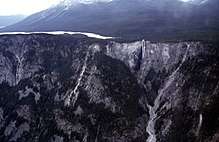Hunlen Falls
Hunlen Falls is a waterfall in the Pacific Ranges of the Coast Mountains of British Columbia, Canada. It is located in Tweedsmuir South Provincial Park, west of the communities of Tatla Lake, Kleena Kleene and Nimpo Lake, and east of Bella Coola. It is one of the tallest waterfalls in Canada when measured as a continuous unbroken drop. Sources vary, but the official BC Parks measurement is 260 m (853 ft).[1] Other waterfalls such as Della Falls on Vancouver Island are higher, but are of the cascading type. Hunlen Falls drops from the north end of Turner Lake via Hunlen Creek into the Atnarko River, a tributary of the Bella Coola River.[2][3] Erosion of the canyon below Hunlen Falls has created an alluvial fan into the Atnarko Valley.

The falls were named in 1947 after a Chilcotin Chief named Hana-lin, who used to fish below the falls in the autumn with a fish trap, and trap game nearby.[4] In the 1930s it was sometimes called Mystery Falls and before that occasionally called Bella Coola Falls.
Access

There is no road to Hunlen Falls. The easiest access is by float plane from Nimpo Lake, about a 20-minute flight. Planes land on Turner Lake above Hunlen Falls and the walk on a good trail takes about 30 minutes to the unfenced viewpoint on the east rim of the canyon.
There is a hiking trail to Hunlen Falls, starting from Highway #20 at the foot of the Bella Coola Hill. Starting from Highway #20 the Tote Rd offers 4x4 access to the trailhead. The trail is approximately 16 km (10 mi) long.[5] The trail to Turner Lake is cleared and maintained by BC Parks and volunteers.
Nearby area
Lonesome Lake is about 2 km (1.2 mi) to the east of Turner Lake, running parallel to it. It is an S-shaped lake nearly 12 km (7.5 mi) in length and visible from the cliffs at Hunlen Falls. The south end of Lonesome Lake was the site of the pioneer homestead of Ralph Edwards, known as "The Birches", which was occupied from 1912 into the 1970s. His life was made famous by the book Crusoe of Lonesome Lake.[6]
In July 2004 lightning struck the ridge between Turner and Lonesome Lake, igniting what has become known as the Atnarko fire which burned into August.[7][8] It burned the southern side of Turner Lake up to the falls, as well as destroying a number of residences including the Edwards and Turner homesteads.
References
- Tweedsmuir (South) Provincial Park: Hunlen Falls/Turner Lake Chain. BC Parks brochure, Feb 2003. http://www.env.gov.bc.ca/bcparks/explore/parkpgs/tweeds_s/hunlen_falls_brochure.pdf?v=1489708800040
- "Hunlen Falls". BC Geographical Names.
- "Hunlen Creek". BC Geographical Names.
- Clayton Mack, Harvey Thommasen (1994).Bella Coola Man: More Stories of Clayton Mack. Pg. 115.
- Scheffel, Richard L.; Wernet, Susan J., eds. (1980). Natural Wonders of the World. United States of America: Reader's Digest Association, Inc. p. 186. ISBN 0-89577-087-3.
- Stowe, Leland (1957). Crusoe of Lonesome Lake. Random House. ISBN 978-0-394-42092-9
- Pat Burkette. "Lonesome Lake fire: Putting the emotion back into it." Archived 2012-09-10 at Archive.today, 2004.
- The Lonesome Lake Fire Archived 2004-12-06 at the Wayback Machine, CHRIS' NUK TESSLI NEWSLETTER. July - August, 2004.